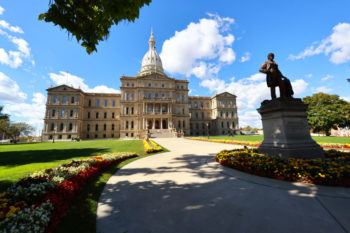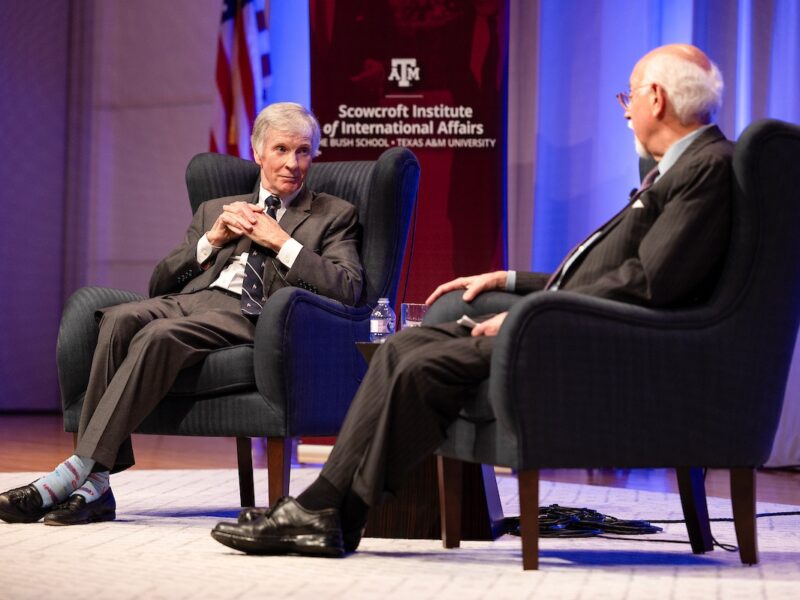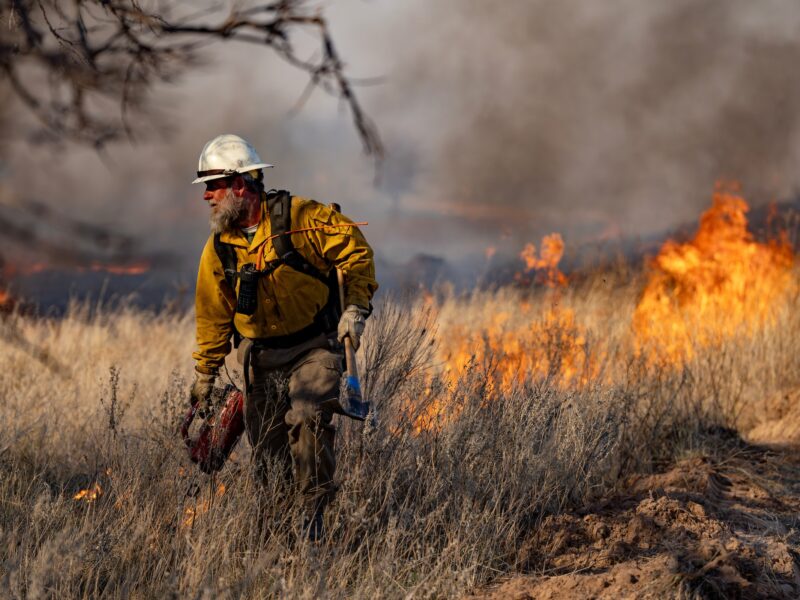The Militia Movement Behind The Attempted Michigan Takeover

A group of 13 men, seven of whom are said to be affiliated with an extremist group called the Wolverine Watchmen, were arrested Thursday by federal and state officials in Michigan on terrorism, conspiracy and weapons charges.
Their plans, officials said, included storming the Michigan State Capitol, abducting Gov. Gretchen Whitmer, and instigating a civil war. Authorities said the men had decided to “unite others” to “take violent action” against state governments that they thought were violating the Constitution. Although an extreme example, such organizations are not uncommon: There were 576 extreme antigovernment groups that were active in 2019, according to the Southern Poverty Law Center.
Danny Davis, associate professor and director of the Bush School of Government and Public Service‘s Graduate Certificate in Homeland Security, has studied domestic terrorism for 30 years. Davis spoke with Texas A&M Today about the history of militia groups and what motivates them.
Texas A&M Today: What is a militia? What actions do they take, and what are their goals?
Davis: The modern militia movement takes its origins from before the founding of our country. From the first colony at Jamestown forward, each community had a local militia. Every citizen was expected to stand as a soldier when called upon. He owed service to the community-controlled militia. If you think about Lexington and Concord and the “shot heard around the world,” the people who fell out to fight the British when they marched out of Boston to seize stockpiles were American militia. That’s the origin of the militia concept. Today, the concept of the citizen-soldier is embodied in the National Guards of each state.
The difference today in these private militia groups is that they are just that, a group of civilians banning together on their own recognizance. They are not controlled by their communities or local government. Different militias have different goals and motivations. Some want to make sure the Second Amendment is upheld. Some can be construed similar to a shooting club. A strict interpretation of the Constitution is another important objective to some. And then there are groups that believe the federal and or a state government have usurped the power that rightly belongs to the people granted under the Constitution. Some groups, like the Wolverine Watchmen, are bent on the overthrow of the U.S. government. There’s a whole spectrum of beliefs held by militia groups. Many commentaries are quick to lump all militia elements into the racially motivated violent extremists category. While that can be the case with some groups, it is certainly not the case with all. It is important to read and or listen to what a particular militia organization says about itself.
What was your reaction to this plot in Michigan, particularly the goal to start a civil war?
That’s the most outlandish or extreme view held by a militia-type group. But, it sounds like they were somewhat organized and had serious intentions. As is often the case, good law enforcement work identified the threat and was able to take down the perpetrators. There’s nothing wrong with going out and shooting and even conducting tactical maneuvers. But when people tie such activities into a plan to storm the Michigan State Capitol and kidnap the governor, the law has been violated and law enforcement is going to respond.
We’ve also seen armed individuals at anti-lockdown protests this year – what do state governments’ handling of the pandemic represent to groups like this?
To folks that hold to a strict interpretation of the Constitution, such actions by a government, regardless of the jurisdictional level, breed distrust and provides examples of government overreach. They believe the authorities are overstepping their constitutional bounds. There were peaceful protests in Michigan over the past weeks supporting such ideas. Apparently the Wolverine Watchmen group decided, “We’re going to break the law, we’re going to try to start the civil war and stop this and take us back where we need to be.”

What kind of history do militia groups have in Michigan?
Michigan has always been a state with significant militia activity. In 2010 there was a group called the Hutaree. Nine members of the Hutaree militia were arrested because they were conspiring to “levy war against the United States.” The Hutaree allegedly planned to murder a policeman and then assault the funeral. The government charges stated that the conspirators’ goal was to inspire a revolution against the government.
They went to trial and in 2012, when it all was said and done seven of the nine charges were dismissed, and they were convicted on two weapons charges. Michigan’s got a fair amount of militias operating up there. Some are extreme like this Wolverine Watchmen group and the Hutaree. But there are others, holding the same convictions, but living within the law.
The restrictions Gov. Whitmer imposed in response to COVID-19, particularly when she extended them as other states began to ease up, I believe flew directly into the overstepping / anti-government theme that many in that state held, including the men arrested this week. The large issue is the domestic politics debate of a strong central government or more dispersed control to the states. The Wolverine Watchmen stepped across the line, breaking the law to forward their ideas.
How did the modern day America militia movement start?
It’s pretty extensive and goes back to the late 1980s. In those years the anti-abortion movement got going and along with that you had extreme right wing-thinking people who began to believe that the federal government was out of control, overbearing and was leaving the Constitution behind. That is when some of these militia groups started coming out of the woodwork. During the Clinton Administration, actions at Ruby Ridge, the Branch Davidian compound in Waco, and other law enforcement actions caused an increased distrust of the federal government in some segments of American society. One of the outcomes was an increase in the popularity of private militias. And like today’s militias, motivations varied.
At the same time, there grew up a concept of “leaderless resistance.” This idea actually came out of the Cold War and the fear that the Soviet Union would conquer the U.S. After law enforcement successfully took down multiple resistance or terrorists cells, Louis Beam, a Klansman, modified the idea to enable resistors of the extreme right to continue to resist the “corrupt” federal government. This concept is that each resistor works alone or in a very small cell of people. The resistor keeps his own counsel, not divulging plans or ideas to anyone. Some Salafi-jihadist attacks and Timothy McVeigh’s bombing of the Murrah Building in Oklahoma City are examples of “leaderless resistance” in action.
How common is it for people with these views to move past private meetings and peaceful demonstrations and actually make plans to carry out acts of violence?
You can go back to Timothy McVeigh in the early nineties. You can go back even further, before the War Between the States with John Brown. In New England there was an abolition movement. It was actually centered in Protestant churches at the time. John Brown, an ardent abolitionist, stepped outside the law and organized a militia. His goal was to start a slave revolt. He conspired, murdered and burned until he was captured, tried and executed.
Similar to Brown and his anti-slavery stance, today there are folks who feel so strongly against abortion that they will to set fire to an abortion clinic or shoot a doctor to try to stop what they consider murder.
How much of a threat are these anti-government groups?
I think that the federal government and law enforcement are pretty good at keeping a handle on what’s going on with such groups. The Michigan arrests are a perfect example. From all indications the feds are pretty good about deciding when to keep somebody or some group under surveillance and when to move in and make an arrest.
You mentioned changes in political administrations being a catalyst for this sort of activity. With a highly contested election approaching in a few weeks, what is that going to do to shift the landscape for these groups?
If Biden and Harris get in there, a lot of folks are going to be very concerned with the direction they want to take America. On the other hand, if Trump gets another four years, there are a lot of people who are very concerned with that direction. There’s a great divide. What both sides need to do is work in the political process, within the law.
What else would you like to mention?
In these different political and societal movements there are honest people that honestly believe. And there are others that may offer legitimate opposition to a position. Lawful activity for a cause is the way folks have got to work. It is not useful to try to color a legitimate group or a movement by the illegal actions some might perpetrate to forward the cause. When people cross the line and break the law — and it happens on both sides of the spectrum — they need to be prosecuted.
Media contact: Caitlin Clark, caitlinclark@tamu.edu




